Ultrastructure and molecular phylogeny of Calkinsia aureus: cellular identity of a novel clade of deep-sea euglenozoans with epibiotic bacteria
- PMID: 19173734
- PMCID: PMC2656514
- DOI: 10.1186/1471-2180-9-16
Ultrastructure and molecular phylogeny of Calkinsia aureus: cellular identity of a novel clade of deep-sea euglenozoans with epibiotic bacteria
Abstract
Background: The Euglenozoa is a large group of eukaryotic flagellates with diverse modes of nutrition. The group consists of three main subclades - euglenids, kinetoplastids and diplonemids--that have been confirmed with both molecular phylogenetic analyses and a combination of shared ultrastructural characteristics. Several poorly understood lineages of putative euglenozoans live in anoxic environments, such as Calkinsia aureus, and have yet to be characterized at the molecular and ultrastructural levels. Improved understanding of these lineages is expected to shed considerable light onto the ultrastructure of prokaryote-eukaryote symbioses and the associated cellular innovations found within the Euglenozoa and beyond.
Results: We collected Calkinsia aureus from core samples taken from the low-oxygen seafloor of the Santa Barbara Basin (580 - 592 m depth), California. These biflagellates were distinctively orange in color and covered with a dense array of elongated epibiotic bacteria. Serial TEM sections through individually prepared cells demonstrated that C. aureus shares derived ultrastructural features with other members of the Euglenozoa (e.g. the same paraxonemal rods, microtubular root system and extrusomes). However, C. aureus also possessed several novel ultrastructural systems, such as modified mitochondria (i.e. hydrogenosome-like), an "extrusomal pocket", a highly organized extracellular matrix beneath epibiotic bacteria and a complex flagellar transition zone. Molecular phylogenies inferred from SSU rDNA sequences demonstrated that C. aureus grouped strongly within the Euglenozoa and with several environmental sequences taken from low-oxygen sediments in various locations around the world.
Conclusion: Calkinsia aureus possesses all of the synapomorphies for the Euglenozoa, but lacks traits that are specific to any of the three previously recognized euglenozoan subgroups. Molecular phylogenetic analyses of C. aureus demonstrate that this lineage is a member of a novel euglenozoan subclade consisting of uncharacterized cells living in low-oxygen environments. Our ultrastructural description of C. aureus establishes the cellular identity of a fourth group of euglenozoans, referred to as the "Symbiontida".
Figures


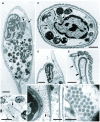
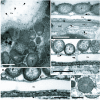


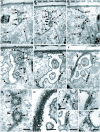
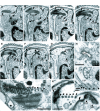

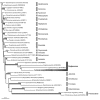

Similar articles
-
Euglenozoa: taxonomy, diversity and ecology, symbioses and viruses.Open Biol. 2021 Mar;11(3):200407. doi: 10.1098/rsob.200407. Epub 2021 Mar 10. Open Biol. 2021. PMID: 33715388 Free PMC article. Review.
-
Ultrastructure and molecular phylogenetic position of a novel euglenozoan with extrusive episymbiotic bacteria: Bihospites bacati n. gen. et sp. (Symbiontida).BMC Microbiol. 2010 May 19;10:145. doi: 10.1186/1471-2180-10-145. BMC Microbiol. 2010. PMID: 20482870 Free PMC article.
-
Identity of epibiotic bacteria on symbiontid euglenozoans in O2-depleted marine sediments: evidence for symbiont and host co-evolution.ISME J. 2011 Feb;5(2):231-43. doi: 10.1038/ismej.2010.121. Epub 2010 Aug 5. ISME J. 2011. PMID: 20686514 Free PMC article.
-
Phylogenetic position and inter-relationships of the osmotrophic euglenids based on SSU rDNA data, with emphasis on the Rhabdomonadales (Euglenozoa).Int J Syst Evol Microbiol. 2001 May;51(Pt 3):751-758. doi: 10.1099/00207713-51-3-751. Int J Syst Evol Microbiol. 2001. PMID: 11411694
-
Comparative molecular cell biology of phototrophic euglenids and parasitic trypanosomatids sheds light on the ancestor of Euglenozoa.Biol Rev Camb Philos Soc. 2019 Oct;94(5):1701-1721. doi: 10.1111/brv.12523. Epub 2019 May 16. Biol Rev Camb Philos Soc. 2019. PMID: 31095885 Review.
Cited by
-
Evolution of metabolic capabilities and molecular features of diplonemids, kinetoplastids, and euglenids.BMC Biol. 2020 Mar 2;18(1):23. doi: 10.1186/s12915-020-0754-1. BMC Biol. 2020. PMID: 32122335 Free PMC article.
-
Euglenozoa: taxonomy, diversity and ecology, symbioses and viruses.Open Biol. 2021 Mar;11(3):200407. doi: 10.1098/rsob.200407. Epub 2021 Mar 10. Open Biol. 2021. PMID: 33715388 Free PMC article. Review.
-
Inventory and Evolution of Mitochondrion-localized Family A DNA Polymerases in Euglenozoa.Pathogens. 2020 Apr 1;9(4):257. doi: 10.3390/pathogens9040257. Pathogens. 2020. PMID: 32244644 Free PMC article.
-
Ultrastructure and molecular phylogenetic position of a novel euglenozoan with extrusive episymbiotic bacteria: Bihospites bacati n. gen. et sp. (Symbiontida).BMC Microbiol. 2010 May 19;10:145. doi: 10.1186/1471-2180-10-145. BMC Microbiol. 2010. PMID: 20482870 Free PMC article.
-
Ciliary transition zone evolution and the root of the eukaryote tree: implications for opisthokont origin and classification of kingdoms Protozoa, Plantae, and Fungi.Protoplasma. 2022 May;259(3):487-593. doi: 10.1007/s00709-021-01665-7. Epub 2021 Dec 23. Protoplasma. 2022. PMID: 34940909 Free PMC article. Review.
References
-
- Keeling PJ, Burger G, Durnford DG, Lang BF, Lee RW, Pearlman RE, Roger AJ, Gray MW. The tree of eukaryotes. Trends Ecol Evol. 2005;20:670–676. - PubMed
-
- Adl SM, Simpson AGB, Farmer MA, Andersen RA, Anderson OR, Barta JR, Bowser SS, Brugerolle G, Fensome RA, Fredericq S, James TY, Karpov S, Kugrens P, Krug J, Lane CE, Lewis LA, Lodge J, Lynn DH, Mann DG, McCourt RM, Mendoza L, Moestrup Ø, Mozley-Standridge SE, Nerad TA, Shearer CA, Smirnov AV, Spiegel FW, Taylor MF. The new higher level classification of eukaryotes with emphasis on the taxonomy of protists. J Eukaryot Microbiol. 2005;52:399–451. - PubMed
-
- Adl SM, Leander BS, Simpson AGB, Archibald JM, Anderson OR, Bass D, Bowser SS, Brugerolle G, Farmer MA, Karpov S, Kolisko M, Lane CE, Lodge DJ, Mann DG, Meisterfeld R, Mendoza L, Moestrup Ø, Mozley-Standridge SE, Smirnov AV, Spiegel F. Diversity, nomenclature, and taxonomy of protists. Syst Biol. 2007;56:684–689. - PubMed
Publication types
MeSH terms
Substances
LinkOut - more resources
Full Text Sources
Molecular Biology Databases

